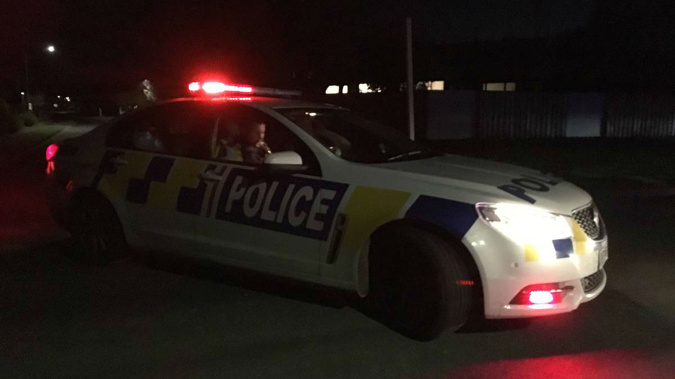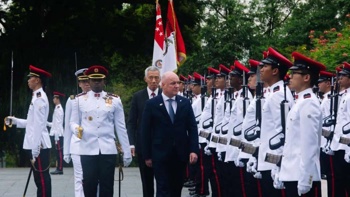
A major review of the police pursuit policy makes no radical changes and the practice will not be banned or pared back in any way.
The Independent Police Conduct Authority ruled that the current policy "can provide the necessary balance between public safety and public protection" - however it has made eight recommendations to "enhance police understanding" of the rules.
The review also highlights the need for further research to understand why some drivers flee.
It looked at a sample of 268 fleeing driver events. Out of this sample, 159
fleeing drivers were able to be identified. The review found:
• Nearly all fleeing drivers were male
• More than half were serious and persistent criminal offenders with multiple
previous convictions
• Around half had been in prison before
• One-third had at least one previous conviction for fleeing police
"New Zealand Police Fleeing Drivers in New Zealand: a collaborative review of events, practices, and procedures attached" is a joint review by the police and the IPCA.
It was released to the public at midday today.
The review was based on a case study of pursuits over a certain period and was not an all-encompassing review on whether the practice should stay or go.
The review comes at the end of The Chase - a four day Herald series looking into pursuits and the people involved.
Police have engaged in more than 30,000 pursuits in the past 10 years, during which time 79 people have been killed in crashes.
Others have been killed in pursuit-related incidents including police shootings - and hundreds, including those in the fleeing cars and the patrol cars chasing them, have been injured.
Earlier this week families of those killed in pursuits called for an end to the practice.
Some wanted changes to better protect teenage drivers from being chased by police.
But neither of those things have come to fruition.
IPCA chairman Judge Colin Doherty said the report "endorses the current policy approach" to fleeing driver events but highlighted eight recommendations to enhance the police understanding and application of the policy - including changes to the way pursuits are handled, the training given to officers and the way the events are recorded and investigated.
He said the recommendations would be "an expensive undertaking".
"It's not all going to happen overnight," he said.
A review into whether police should engage in pursuits at all was not held because the police didn't have the ability to look into it at the time.
Judge Doherty said what was needed to undertake such a review might be "the will to do it" from police.
The recommendations today, which have all been accepted by police and will be implemented through a substantial action plan outlined in the review, are
• Police will improve the skills, knowledge and experience of all staff involved in fleeing driver events, through different learning channels, to enable robust decision-making and support the effective management of events.
• Police will review the fleeing driver policy against the findings of the review and make any necessary adjustments to the policy and standard operating procedures to ensure that they remain fit for purpose and support the effective management of fleeing driver events.
• Police will investigate allowing units to carry out a non-compliant vehicle stop on offending vehicles that have been successfully spiked and are travelling at low speeds, to mitigate risks and improve the safe resolution of fleeing driver events.
• Police will strengthen the accountability mechanisms of fleeing driver events, including improvements to post-event follow-up, and district review and national oversight processes.
• Police will review the Air Support Unit's (Eagle) involvement in the management of fleeing driver events and clarify the role that they play if necessary
• Police will review the Police Professional Driver Programme, including current driver classification systems, to identify opportunities for improving staff understanding and application of their Threat, Exposure, Necessity, Response (TENR) tool during fleeing driver events.
• Police will explore ways of improving communication centre's access to real-time information, including through the potential adoption of new technology, in partnership with our sector partners.
• Police will commission further research and analysis of fleeing drivers to improve our understanding of drivers' motivations for fleeing, including a focus on young people and alcohol/drug impaired drivers.
/arc-anglerfish-syd-prod-nzme.s3.amazonaws.com/public/4DZRABTVHJGXTPIJMJ3YRODJXI.jpg)
The review also highlights the need for further research to understand why some drivers flee.
And it highlighted the fact that some police staff do not always "appropriately consider" the safety of the fleeing driver or passengers that may be in the vehicle at the time - some of whom may be present unwillingly.
Judge Doherty said the existing restrictive policy could provide the necessary balance between public safety and public protection in pursuits - if police officers understand it and apply it properly.
"It is clear the training police currently receive does not adequately prepare them for these complex and dynamic events," he said.
"Ensuring officers are equipped to make good decisions when assessing risk and providing training which reinforces a risk-averse mind-set, is critical to ensuring the safety of the public, officers and offenders.
"Embedding a risk-averse mind-set in police staff is one of the keys to the safe management of fleeing driver events."
This is the sixth review of police pursuits, but the first where the two agencies have taken a collaborative approach.
Judge Doherty said that allowed police and the IPCA to undertake a more detailed analysis, enabling both organisations, key stakeholders and the public to better understand the fleeing driver environment.
Going forward, the IPCA will independently and regularly monitor the implementation of the recommendations and the results of that monitoring will be reported in its annual reports to parliament.
/arc-anglerfish-syd-prod-nzme.s3.amazonaws.com/public/GVZJEMK52NH4LCPFAC6BRSQZMU.jpg)
Police Commissioner Mike Bush welcomed the release of the review and said while it showed current fleeing driver management was "sound overall", the recommendations would "improve practice".
"The review has shown that our staff generally manage fleeing driver events well, affirming the principles underpinning our policy," he said.
"However, there are clear areas we can, and need to improve.
"This includes improving how some of our staff conduct risk assessment, providing enhanced cognitive-based training for managing these complex and high-risk events, and improving communication between our frontline staff and our communications centres."
Bush said police have set a time period up to one-and-a-half years to get all officers retrained, though he said current training was "very comprehensive".
He said the driving was not the issue, but the decision-making.
Bush described the decision to pursue as "one of the most complex, difficult, and serious" police make.
"All too tragically, whenever drivers flee from us, their actions can cause crashes that seriously injure or kill people," he said.
"We know these are high-risk events with potentially devastating consequences. These drivers are people's partners, children, and friends.
"But drivers who flee are not only risking their lives and those of their passengers, but the lives of innocent people in our communities.
"Unfortunately, people are still making the choice to flee from police - so we want to ensure our police response to drivers who choose to flee is as safe as possible.
"We would not be here today if everyone pulled over and stopped when police asked them to."
/arc-anglerfish-syd-prod-nzme.s3.amazonaws.com/public/YRWKMRZJQNG6JKHDD75DLR7KQI.jpg)
THE RECOMMENDATIONS - WHY THEY WERE MADE
A number of areas were identified where police staff needed more training and guidance around the pursuit policy.
For example, the review found that sometimes staff could do better at relaying live information to communications centres during an incident.
"The review found that, for a range of reasons, this information is often not forthcoming," the report said.
"Ensuring an appropriate flow of relevant information is critical for an effective control and command structure.
"Not having quality information flow significantly hinders relevant parties in appreciating the risks involved in a fleeing driver event.
"As communications staff are not physically present at the event, there is significant reliance on frontline staff providing accurate and relevant information, in order for comms to undertake robust and effective decision making."
The report also stated some police had a "lack of understanding" of the shared decision-making around pursuits.
"Although the lead driver normally decides whether to start to pursue a fleeing driver, comms staff have an important role in providing objective oversight and management of the event," it said.
"This is particularly important given the high adrenaline nature of fleeing driver events, where frontline units are often confronted with multiple and sometimes competing tasks.
"Overall, safely resolving a fleeing driver event represents a joint exercise between frontline and communications staff, with each party playing a crucial role in collectively understanding and managing risks throughout the event.
"The review found, however, that sometimes staff do not fully comprehend the respective roles and responsibilities, and do not support the devolution of decision-making in the shared decision-making model.
Some staff believe that abandonment decisions should ultimately rest with frontline staff - which resulted in abandonment decisions by comms centres creating tensions in the relationship, especially when the rationale behind these decisions is not communicated to the staff involved.
"In practice, this can result in comms not having effective control and command of any post-abandonment activities," the report concluded.
Other shortcomings were also identified in terms of how police implement their pursuit policy.
/arc-anglerfish-syd-prod-nzme.s3.amazonaws.com/public/N7ERMA5UWJEBRDFDLRP575KYK4.jpg)
Initiating pursuits
In terms of initiating pursuits, the review found that some police "do not adequately consider the necessity or proportionality of intervention against the risk posed" by the fleeing driver.
"In such cases, the response is justified on the assumed basis that the driver is fleeing for some specific but unknown reason and needs to be apprehended," the review found.
"The more appropriate assessment would be to consider whether the risk of pursuing outweighs the need to apprehend an offender, particularly for a low-level or suspected offence.
"A further key issue that the review identified is that staff could do more to adequately consider how police intervention can escalate the risk – in terms of increasing the risk exposure to all road users, and specifically in terms of adversely influencing the fleeing driver's behaviour.
"There is a significant opportunity to improve staff appreciation of how their intervention contributes to risk, so that it can be appropriately considered in the risk assessment. This will help ensure that the response remains proportionate to the threat posed by the fleeing driver."
Abandoning pursuits
The review found that some staff also considered it "necessary" to pursue a fleeing driver until the incident was "resolved" which was problematic.
"This is based on the perceived need to apprehend and hold the offender accountable for their actions," the report stated.
"Some staff do not give adequate consideration as to how to reduce the risk the offender poses to the safety of themselves and other road users.
Officer mindset
Although officers are empowered to exercise their own professional judgment in determining how to respond to a fleeing driver - the police restrictive policy approach provides clear direction about how officers should exercise this discretion.
However, the review found that the way that officers translate this guidance into practice depended heavily on individual approaches to risk management generally.
"In an environment where risk is a constant variable, it is inevitable that officers will assess and manage risk according to their own frame of reference – for example, from their own previous experience and the experience of others," the report said.
"This means that some officers may manage risk more proactively, while others may underestimate both the risk and the need to manage it.
"Therefore, ensuring that staff can adequately identify and consider the risks, both before and during pursuits, is critical for ensuring that responses are well considered and necessary, and remain proportionate to the threat being addressed.
The review found that a good proportion of staff adopt a more risk-averse approach but others were more "risk-tolerant" and took unnecessary risks to apprehend offenders for what appear to be relatively minor offences.
While acknowledging that there can be a tension between "balancing the need to maintain law and order with keeping the public safe" the review concluded that a risk-averse approach to fleeing driver events "more effectively balances the risk of not pursuing against the risk of continuing".
"Therefore, a risk-averse approach needs to be embedded into the entire staff mind-set in the management of fleeing driver events.
"This is needed to ensure staff prioritise safety when responding to a fleeing driver."
Effectiveness of current training
The review found that police felt current training does not fully prepare them for managing fleeing driver events.
And, there was general concern that the initial training for recruits should be reviewed and improved, the frequency of refresher training could be increased, as could improving the focus on replicating real-life pressure situations.
The review considered that there was an opportunity to explore how the current training could be improved, including investigating the potential use of simulator training.
"The use of a simulator trainer would provide staff with an opportunity to test their reaction to a high speed pursuit as part of this training," the report said.
"Officers cannot currently be tested on this, as they can only drive at high speeds on public roads in response to a real-life situation.
"The impact of training on staff attitude also cannot be underestimated."
Fleeing driver accountability process
The review found that police accountability processes for fleeing driver events had "considerable scope for improvement".
Currently, the only obligation on staff after a pursuit is to complete a fleeing driver notification form, which records a range of information about the event.
But the review found the forms provided insufficient information to carry out a robust review process.
"Consequently, the review found that this review process was often superficial and provided little organisational accountability for decision-making. More importantly, this lack of accountability reduces any learning opportunities for the organisation," said the report.
In other crime categories, police create a case file, enter information into the National Intelligence Application and carry out follow-up inquiries.
The review found that due to the increasing rate of abandonment, staff carrying out inquiries after a pursuit was important for ensuring that offenders are held accountable to the greatest possible extent.
"The review considers that strengthening the accountability processes would better enable staff to carry out inquiries after an event. The organisation as a whole would also be better positioned to identify and address issues with managing fleeing driver events."
Pursuits - the facts
• Since January 2008 there have been 30,950 police pursuits.
• The number of pursuits has increased steadily each year for the past decade.
• During those pursuits, 79 drivers and passengers were killed in crashes
• Police figures show that pursuits are most likely to happen between 10pm and 6am.
• Crashes are more likely at night.
• The majority of drivers are young males and many are driving stolen cars.
Take your Radio, Podcasts and Music with you









